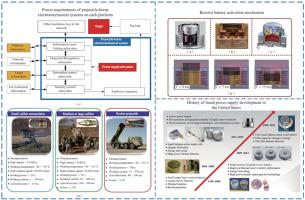Power supply for the projectile-borne electromechanical system: A review
IF 16.4
引用次数: 0
Abstract
Wide-area battlefields, smart ammunition, and precision damage are the new directions of modern warfare, while munition-borne electric systems serve as “decision-makers” for smart ammunition. As the primary energy supplier for the entire system, munition-borne power sources hold a veto power position. The complexity of the application environment for munition-borne power sources involves enduring high overloads, high centrifugal forces, ballistic aerothermal effects, variations in ballistic airflow fields, central blast impacts, complex disturbances in indefinite postures, and even the influence of complex ionized media. These factors represent weak links in research on the entire munition-borne electric system. Therefore, nations around the world attach great importance to developing munition-borne power sources and conducting research on various related aspects, such as technological innovation, digital simulation, and testing techniques. This paper elaborates on the existing technologies and scientific issues facing munition-borne power sources, comparing and analyzing the advantages and disadvantages of liquid reserve batteries, solid-state thermoelectric batteries, and supercapacitors as energy sources for modern warfare systems. It also discusses current technological developments and future challenges. To address the insufficient environmental and spatial adaptability of munition-borne power sources, this paper proposes a design approach that couples excitation with integrated packaging. Specifically, although the diversity of ammunition platforms leads to differences in power source requirements, common problems faced by munition-borne electric systems in modern battlefield environments include extreme impact mechanics, low-temperature rapid activation requirements, and structural size limitations. This paper comprehensively discusses the extreme mechanical environments of ammunition platforms, failure mechanisms and protection methods under high-impact conditions for munition-borne power sources, low-temperature rapid activation, and miniaturization design and proposes protective design concepts such as elastic skeleton structures and high-pressure sealed secondary packaging. Additionally, these findings suggest the use of capillary microarray structures with electrode membranes to increase infiltration rates and further improve the activation rate of munition-borne power sources. Lastly, this paper outlines future directions for the development of munition-borne electrical system power sources, primarily from the perspectives of non-reserve primary batteries, non-bottle-breaking reserve batteries, new system batteries, and the advantages of battery-supercapacitor composite energy, providing a reference for the design of munition-borne electrical system power sources used in diversified weapon system platforms.

弹载机电系统电源研究进展
广域战场、智能弹药、精确毁伤是现代战争的新方向,而弹载电气系统是智能弹药的“决策者”。作为整个系统的主要能源供应商,弹药源拥有否决权。弹载电源应用环境的复杂性包括承受高过载、高离心力、弹道气动热效应、弹道气流场的变化、中心爆炸冲击、不确定姿态的复杂干扰,甚至复杂电离介质的影响。这些因素反映了整个弹载电力系统研究的薄弱环节。因此,世界各国都非常重视弹载电源的发展,并在技术创新、数字仿真、测试技术等各个方面进行研究。阐述了弹载电源面临的现有技术和科学问题,比较分析了液体备用电池、固态热电电池和超级电容器作为现代战争系统能源的优缺点。它还讨论了当前的技术发展和未来的挑战。针对弹载电源环境和空间适应性不足的问题,提出了一种激励与集成封装耦合的设计方法。具体而言,尽管弹药平台的多样性导致了动力源需求的差异,但在现代战场环境中,弹药载电系统面临的共同问题包括极端冲击力学、低温快速激活要求和结构尺寸限制。本文对弹药平台的极端机械环境、弹载电源在高冲击条件下的失效机理及防护方法、低温快速激活、小型化设计等进行了全面探讨,提出了弹性骨架结构、高压密封二次封装等防护设计理念。此外,这些发现表明使用电极膜的毛细管微阵列结构可以增加渗透速率,进一步提高弹药载电源的激活率。最后,重点从非备用原电池、非破瓶备用电池、新型系统电池以及电池-超级电容器复合能源的优势等方面概述了弹载电力系统电源的未来发展方向,为多种武器系统平台使用的弹载电力系统电源的设计提供参考。
本文章由计算机程序翻译,如有差异,请以英文原文为准。
求助全文
约1分钟内获得全文
求助全文

 求助内容:
求助内容: 应助结果提醒方式:
应助结果提醒方式:


